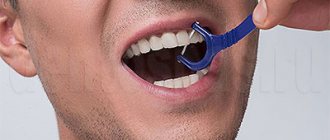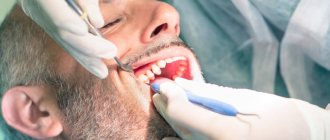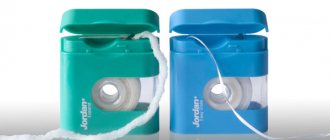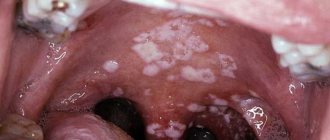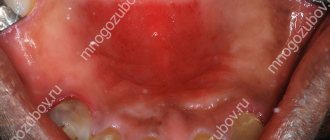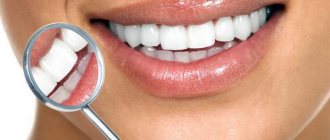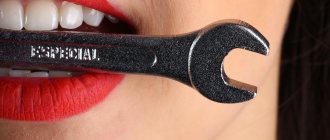Modern methods of professional teeth cleaning are safe and comfortable for the patient. The procedure can be performed even during pregnancy.
Complex cleaning is practically painless; in very rare cases, anesthesia is required. Removal of hard dental deposits and soft plaque is carried out in several stages:
- Tartar removal. First, all hard dental deposits are removed. The procedure is carried out using ultrasound.
- Cleansing using the Air Flow device. Under the influence of water pressure containing abrasive particles, tooth enamel is not only cleaned of soft plaque, but also whitened to its natural shade.
- Polishing. After brushing, the surface of the teeth becomes slightly rough, which will contribute to the rapid accumulation of plaque. To avoid this, the tooth surface is treated with special discs and bristles. After the procedure, the enamel becomes smooth and protected from the effects of pathogenic microflora.
- Treatment with antiseptics. To prevent the spread of infection and to prevent gum inflammation, the oral cavity is treated with an antiseptic solution.
- Fluoridation. After cleaning, the teeth are coated with fluoride varnish to strengthen and reduce the sensitivity of the enamel.
- Applying therapeutic bandages. In case of severe gum inflammation and periodontal bleeding, special therapeutic dressings are applied. The dressings may contain antiseptics, antiviral drugs, and antibiotics.
Causes of enamel hyperesthesia
Many patients complain of increased sensitivity of teeth after tartar removal. The main reason for such complaints is the exposure of hard tooth tissues that were previously covered with tartar. The deposits partially reduced the impact of irritants - high and low temperatures, sour, sweet and spicy foods. Therefore, after the stone is removed, the enamel reacts more sharply to external factors.
Increased tooth sensitivity is caused by:
- existing diseases of the oral cavity - caries, pulpitis,
- thinning of tooth enamel in the cervical area,
- non-compliance with professional cleaning rules.
To reduce the likelihood of enamel hyperesthesia, have your teeth cleaned only by qualified dentists. Contact only experienced specialists in whose professionalism you are confident.
Rehabilitation after the procedure
To prevent gum inflammation from starting after the procedure, and for the results to last for a long time, the patient is required to properly care for the oral cavity.
What is required from the patient:
- Do not consume coloring foods and drinks for the first 24 hours after the procedure. These products include: colored fruits, vegetables and berries, coffee, red wine and natural juices.
- Immediately after the procedure, do not drink too hot or cold drinks.
- Immediately after brushing, replace the old toothbrush with a new one.
- Not only use a toothbrush twice a day, but also use dental floss and irrigator at least once a day.
- Be sure to visit your dentist every six months for a routine preventive examination.
- Do not neglect professional teeth cleaning, undergo the procedure regularly according to the indications of a specialist. As a rule, doctors recommend undergoing a comprehensive cleaning twice a year.
Complex of symptoms
Increased sensitivity of teeth after cleaning from tartar can manifest itself in different ways. Most often, patients feel:
- discomfort when chewing food and brushing teeth,
- aching pain of varying degrees of intensity when leaving a warm room into the cold, eating hot and cold foods and drinks.
Normally, this condition can persist for 2-7 days. If enamel hyperesthesia does not go away or worsens over time, do not delay your visit to the dentist.
Teeth hurt after ultrasonic cleaning: what to do?
Ultrasonic tartar removal is a modern way to get rid of hard deposits that cause infectious diseases of the oral cavity. This is a safe and comfortable procedure that is recommended for everyone, even pregnant women. But there is an exception to the rule - these are patients with thin damaged enamel, the ultrasound effect on which can cause pain both during and after sanitation
The fact is that tooth sensitivity may increase after ultrasonic cleaning. Therefore, before going for this procedure, you need to consult a dentist.
What is ultrasonic cleaning
Ultrasonic cleaning uses special dental equipment - an ultrasonic scaler. The principle of its operation is to generate ultrasonic waves, which, when they hit the surface of a tooth, soften plaque of varying degrees of density and remove it. In order to achieve maximum effect, the amplitude and frequency of the waves are adjusted individually for each patient. After treatment, the tooth surface becomes smooth and shiny, and also brightens by 1-2 tones.
Why can teeth hurt after ultrasonic cleaning?
If a patient’s teeth hurt after ultrasonic cleaning, this can be caused by two reasons. First of all, increased sensitivity of teeth associated with defects or damage to the enamel. Therefore, before using this service, you should strengthen your tooth enamel with fluoride-containing products and carry out a deep fluoridation procedure in a dental clinic. The second cause of pain after ultrasonic cleaning is inflammatory diseases of the oral cavity: periodontal disease, gingivitis, caries and others. Scaling may be necessary to treat these conditions. In this case, to relieve the patient from pain during the procedure, dentists use local anesthesia. The doctor will also prescribe painkillers and anti-inflammatory medications to take after ultrasonic cleaning.
What to do if your teeth hurt after ultrasonic cleaning
You can relieve pain after ultrasonic teeth cleaning at home. Applications with antimicrobial anti-inflammatory drugs (for example, Metrogil-denta, Traumeel S and others) will help relieve inflammation, relieve pain, and relieve swelling of the soft tissues of the oral cavity. If the neck of the tooth is particularly sensitive, toothpastes containing fluoride and herbal rinses should be used to care for the oral cavity. If a set of home hygiene procedures does not help relieve pain and/or it intensifies, then you need to visit a dental clinic, where specialists will select adequate treatment.
Expert opinion
Strict adherence to your dentist’s recommendations for oral care will help you avoid pain after ultrasonic tartar removal. Doctors advise brushing your teeth every time after eating on the first day after the procedure, using a soft brush and toothpaste for sensitive teeth.
It is also necessary for the first time to avoid eating cold, hot, spicy and sour foods, which have an aggressive effect on sensitive enamel.
Agree, these are quite simple and feasible medical prescriptions! If they are followed, removing tartar with ultrasound will be extremely comfortable - after all, this is the safest and most painless way to get rid of tartar used in modern dentistry.
Treatment and prevention measures
To reduce the risk of developing hyperesthesia, fluoridation is carried out after professional hygiene with the removal of tartar. Procedure:
- saturates the enamel with useful substances that help strengthen it and restore its structure,
- reduces the likelihood of developing caries.
To avoid enamel hypersensitivity after removing tartar, you must follow the following rules:
- do not eat or drink for two hours after the procedure,
- give up solid and rough foods for a day,
- use a toothbrush with soft bristles,
- Use mouth rinses regularly.
To maintain healthy teeth and gums, professional hygiene with the removal of soft bacterial plaque and tartar should be carried out twice a year.
Causes of toothache
If your teeth were completely healthy before the planned cleaning, after the hygienic procedure they practically do not hurt, although now it is rare to find a person whose dental condition can be considered impeccable in all respects. Many people have caries, there is increased sensitivity due to tooth enamel that is too thin or affected by some disease, and many other dental problems.
During the process of professional cleaning, painful teeth will certainly be disturbed, which will result in their increased sensitivity and, consequently, the patient will experience pain for some time while talking or eating. Moreover, during the hardware cleaning of diseased teeth, when they are exposed to powder compounds, during the polishing process, the patient will experience very unpleasant sensations, comparable to “live” dental treatment.
The salvation is local anesthesia, which will eliminate pain both during the process of the specialist performing each of the stages of cleaning, and for the first time after completion of the procedure. However, after this a person runs the risk of encountering a problem such as severe toothache, therefore, in order to prevent such a situation, it is better to carry out preliminary treatment of the oral cavity, and only then begin cleaning.
The unprofessionalism of the dentist can also cause pain after brushing your teeth, since manipulations performed illiterately or incorrectly can damage tooth enamel. This leads to increased sensitivity and the development of caries, and to avoid such a problem, we recommend contacting the specialists of our clinic, who have many positive reviews and are attentive to each of their patients, trying to choose the optimal way to cleanse the oral cavity of plaque and tartar with the least undesirable consequences .
Surgery
If the gums are severely inflamed and there are deep periodontal pockets, standard professional cleaning may not be effective. To combat inflammation in such cases, surgical treatment is indicated.
- Flap surgery - cutting off the affected areas of soft tissue, removing bacterial deposits under the gum, applying sutures.
- Open curettage is effective for periodontitis and is aimed at deep cleansing of periodontal pockets from granulations and tartar.
The doctor will determine the appropriate treatment tactics after examining the patient.
It hurts to brush your teeth - what could this mean?
Normally, healthy teeth do not hurt when brushing, and in general the oral care procedure does not cause discomfort. If pain does occur, you should definitely consult a doctor to determine the cause.
Why does pain occur?
- Caries, pulpitis and other dental diseases.
If you have untreated teeth in your mouth, they are likely to bother you when brushing. The closer the lesion is to the dental nerve, the more acute the pain. The only way to help in this case is to urgently consult a dentist and treat the aching tooth.
- Injury.
After a fall or impact, tooth enamel may be chipped and the crown portion may be damaged. Depending on the extent of the damage, pain may be constant or occur only upon contact with the tooth - for example, when brushing with a toothbrush. After any injury where teeth may have been damaged, a visit to the dentist is mandatory. If treatment is not started in time, a serious inflammatory process may develop.
- Exposing the neck of the tooth.
The neck is the area of the tooth where the crown portion meets the root. Normally, it is hidden under the gum. With inflammatory diseases of the gums, the neck is exposed, and any touch to the dentin in this area causes acute pain.
- Periodontitis.
With this disease, the gums and other tissues that support the tooth become inflamed. The disease is accompanied by ongoing pain, which usually intensifies when touched.
These are just a few of the reasons that can cause tooth pain when brushing. All of them are pathological and require professional dental treatment. In most cases, after proper therapy, the pain stops and brushing your teeth ceases to cause any discomfort.
How is the ultrasonic teeth cleaning procedure performed in the dentist’s office?
Before the ultrasonic cleaning procedure, the patient’s oral cavity must be examined. During this examination, the doctor determines the quality of hygiene, as well as the amount of dental plaque that needs to be removed. If the patient is concerned about possible pain during ultrasonic teeth cleaning, then local anesthesia is given before the procedure.
After the anesthesia takes effect, an ultrasonic cleaning procedure is carried out, which includes the following sequential steps:
- Ultrasonic cleaning of tooth surfaces during which soft plaque is removed;
- Removal of hard deposits along the gum line;
- Ultrasound cleaning of periodontal pockets.
To remove plaque that has penetrated deep into the enamel pores, Air Flow cleaning technology is additionally used.
The ultrasonic teeth cleaning procedure is completed by grinding and polishing the enamel. To carry out these procedures, special pastes with abrasives and grinding attachments are used. Finally, the tooth enamel is coated with fluoride-containing preparations that strengthen and restore its integrity.
NOTE: Fluoridation or remineralization of enamel is not a mandatory procedure after ultrasonic cleaning. But we advise you not to refuse to carry them out, since fluoridation and remineralization strengthen the enamel, remove hypersensitivity, and act as an excellent prevention of caries.
Disadvantages of ultrasonic cleaning
There are no downsides to ultrasonic cleaning, but you need to know that some pain may still be present during it. Unpleasant sensations are observed when removing plaque from the subgingival space, as well as when treating tooth enamel in the root zone. But there is no need to be afraid or put off ultrasonic cleaning: all possible pain is easily eliminated with local anesthesia.
It is worth considering that ultrasonic cleaning has contraindications. Patients with severe cardiovascular pathologies, people using pacemakers, suffering from asthma and serious respiratory diseases will have to refuse to use ultrasound in teeth cleaning. Ultrasonic cleaning is not carried out in children and adolescents, since the enamel of children's teeth is too thin; young patients may be offered an alternative to ultrasonic cleaning - the Air Flow technique.
Ultrasonic teeth cleaning in a dental clinic in Moscow – “Aesthetica”
We offer our patients a comprehensive oral hygiene service, which includes ultrasonic teeth cleaning and Air Flow removal of pigmented plaque. We carry out procedures using modern and highly efficient equipment, under magnification, which gives us the opportunity to achieve impeccable quality of teeth cleaning.
Our specialists pay close attention to grinding and polishing the teeth after the cleaning procedure. If you do not grind and polish your teeth after removing plaque, it will accumulate quickly and actively. After completing the comprehensive cleaning procedure, our hygienists will definitely introduce you to all the rules of caring for your teeth and oral cavity, and will help you choose the right tools for home hygiene.
You can sign up for a consultation with our specialists at any branch of the Aesthetica clinic in Moscow - in Barvikha or Podsosensky Lane!
Advantages and disadvantages of ultrasonic teeth cleaning
Ultrasonic teeth cleaning is an excellent prevention not only of caries, but also of diseases such as periodontitis, periodontal disease, gingivitis and stomatitis. Ultrasonic cleaning not only effectively removes all types of plaque, but also destroys pathogenic microflora in the oral cavity. The technique is universal and suitable for patients of all ages.
Other benefits of ultrasonic cleaning include:
- Delicacy and safety. Ultrasonic cleaning allows you to clean dental surfaces without damaging the enamel or injuring the gums;
- The ability to remove deposits in the most inaccessible areas of the oral cavity. Only ultrasonic cleaning will effectively remove plaque in the space under the gums;
- Sterilizing ability: ultrasound destroys bacteria;
- Ultrasonic cleaning helps get rid of bad breath and lighten the enamel to its natural color.
Clinical researches
Repeated clinical studies have proven that regular use of preventive toothpaste ASEPTA ACTIVE for a month can reduce bleeding gums by 60%, improve the overall condition of the oral cavity by 44% and reduce inflammation by 33%.
Sources:
- Clinical and laboratory assessment of the influence of domestic therapeutic and prophylactic toothpaste based on plant extracts on the condition of the oral cavity in patients with simple marginal gingivitis. Doctor of Medical Sciences, Professor Elovikova T.M.1, Candidate of Chemical Sciences, Associate Professor Ermishina E.Yu. 2, Doctor of Technical Sciences Associate Professor Belokonova N.A. 2 Department of Therapeutic Dentistry USMU1, Department of General Chemistry USMU2
- Study of the clinical effectiveness of treatment and prophylactic agents of the Asepta line in the treatment of inflammatory periodontal diseases (A.I. Grudyanov, I.Yu. Aleksandrovskaya, V.Yu. Korzunina) A.I. GRUDYANOV, Doctor of Medical Sciences, Prof., Head of Department I.Yu. ALEXANDROVSKAYA, Ph.D. V.Yu. KORZUNINA, asp. Department of Periodontology, Central Research Institute of Dentistry and Maxillofacial Surgery, Rosmedtekhnologii, Moscow
- Report on the determination/confirmation of the preventive properties of personal oral hygiene products “ASEPTA PLUS” Remineralization doctor-researcher A.A. Leontyev, head Department of Preventive Dentistry, Doctor of Medical Sciences, Professor S.B. Ulitovsky First St. Petersburg State Medical University named after. acad. I.P. Pavlova, Department of Preventive Dentistry
- Clinical studies of antisensitive toothpaste “Asepta Sensitive” (A.A. Leontyev, O.V. Kalinina, S.B. Ulitovsky) A.A. LEONTIEV, dentist O.V. KALININA, dentist S.B. ULITOVSKY, Doctor of Medical Sciences, Prof. Department of Therapeutic Dentistry, St. Petersburg State Medical University named after. acad. I.P. Pavlova
Why is tartar dangerous?
Hard dental plaque is a conglomerate of complex composition, formed from microscopic food debris and iron and phosphorus compounds contained in saliva. In fact, the stone grows into the periodontium, and it is not possible to remove it on your own. First, a thick plaque forms on the teeth, which gradually hardens and turns into stone.
Dental plaque promotes the proliferation of pathogenic flora, resulting in caries, gingivitis, and periodontitis. A favorable environment causes rapid growth of pathogenic bacteria and further damage to the periodontium.
The main signs of the appearance of tartar include:
- noticeable stripes, dots, spots of brown (in shades) color on the enamel;
- unpleasant, “heavy” odor from the mouth;
- internal sensation of enamel roughness.
The smile takes on an unaesthetic appearance, and the smell forces the interlocutor to stay away.
It is especially important to monitor the condition of teeth and promptly remove tartar for those who smoke and drink strong tea and coffee. In this case, nicotine and tannins enter into the process of stone formation - deposits form much faster and acquire a characteristic dark brown color.
Important. The end result of an irresponsible attitude towards tartar is tooth loss.
